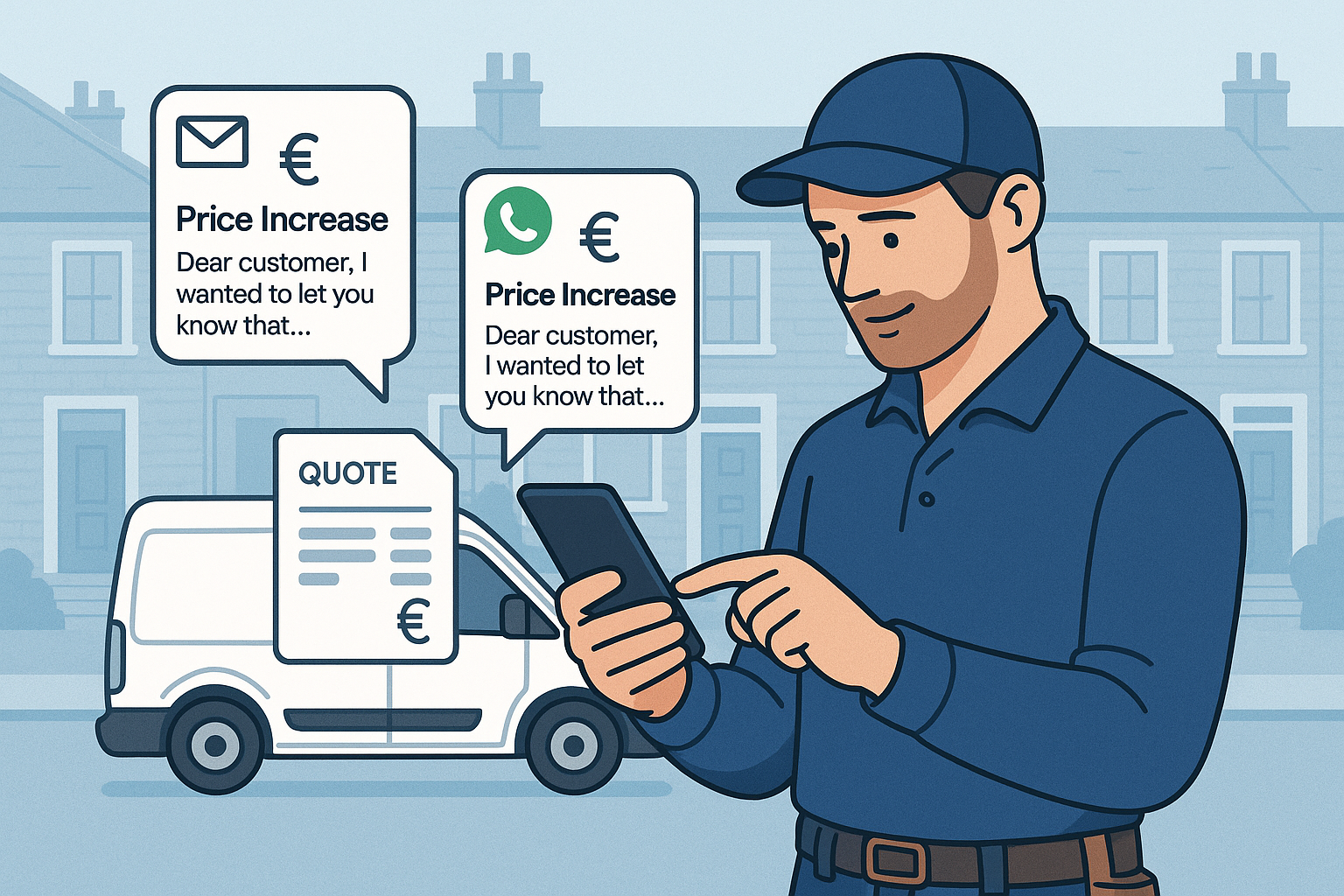
Price increase letter for trades: templates, timing and how to keep customers
Price increase letter for trades: templates, timing and how to keep customers
Category: Business & Operations • Niche: Pricing, credit control, client comms

Engineer sending a polite price increase message on a phone with a van in a UK street
Contents
- Quick answer
- When to raise prices
- How much to increase
- Templates you can copy
- How to send it and who to tell
- Handle pushback without losing the job
- Simple automations to make this easy
- Related reading
- FAQ
Quick answer
- Give 14–30 days’ notice for domestic clients and 30 days minimum for commercial contracts unless your contract says otherwise.
- Keep it short. State the new rate, date it starts, and one or two honest reasons (materials, fuel, wages, compliance).
- Offer options: book at current rates before the change, or lock in a maintenance plan.
- Be consistent. Update your price book and quoting tool so the new rate is used everywhere.
When to raise prices
- Materials or merchant costs have moved 5–10 or more since your last rise.
- Wage rises or labour shortages are hitting margins.
- You are booked out weeks ahead and keep saying yes to low‑margin work.
- New compliance adds time e.g., HSE standards, training, certification.
Tip: Review quarterly. Many UK trades now run small, regular increases instead of big jumps.
How much to increase
- For small jobs: 5–12 depending on cost movement and demand.
- For maintenance contracts: 3–8 annually with CPI link if your terms allow.
- For materials‑heavy work: split labour and materials on quotes so rises are easier to explain and apply.
Use your price book so uplifts are controlled across tasks. If you don’t have one, see Build a trade price book.
Templates you can copy
Use these as email, letter or WhatsApp text. Edit bracketed bits.
Short notice for existing domestic clients (polite)
Subject: Price update from [Your Business] effective [date]
Hi [Name],
Thanks for your custom this year. Due to increased costs of parts, fuel and wages, our call‑out and labour rate will change from [old rate] to [new rate] from [date].
- You can still book work before [date] at the current rate, subject to availability.
- Quotes already sent will be honoured until their expiry date.
If you have questions, reply here or call [number].
Thanks, [Your Name]
Commercial clients on maintenance or frameworks
Subject: Contract rate adjustment from [date]
Dear [Name],
Under clause [x] of our terms and our annual review, we will adjust rates from [date].
- Labour: [old] to [new] per hour/day
- Materials: merchant cost plus [x or actuals]
- Call‑out: [old] to [new]
Drivers: supplier increases, wage adjustments and compliance requirements. We remain committed to response times and first‑time‑fix standards.
Please confirm receipt. We will update POs and portals accordingly.
Regards, [Your Name]
Project quotes not yet accepted (materials volatility)
Subject: Update to quote [ref]
Hi [Name],
We are holding the quoted price to [expiry date]. After that, materials may be repriced at order due to supplier changes. Labour stays at [rate]. If you would like to proceed at the current total, we can schedule now.
Thanks, [Your Name]
WhatsApp version (very short)
Hi [Name] — quick heads up that our rates change on [date] due to supplier and wage rises. New labour rate: [new]. Existing quotes are honoured until expiry. Shout with any questions.
How to send it and who to tell
- Update your quote template footer and invoice terms.
- Email key accounts; WhatsApp or SMS for domestic clients you service regularly.
- Post a simple notice on your website and Google Business Profile.
- Update price lists in your job system (ServiceM8, Jobber, Tradify) and in Xero/QuickBooks items.
See: How to get more Google reviews and Google Business Profile setup.
Handle pushback without losing the job
Common replies and calm responses:
- Can you hold last year’s price? We can honour existing quotes until expiry. For new work we can offer fixed‑price options or schedule before [date] at current rates, subject to availability.
- Another firm is cheaper. We compete on reliability, safety and warranty. We also show costs clearly and use quality parts. If you share the written quote we can check scope apples to apples.
- Why increase now? Parts and wages have risen and we will not cut corners. Small, regular reviews keep service stable.
Simple automations to make this easy
- Build a price book and apply a percentage uplift to a whole task group, then resync to your job system.
- Add a quote follow‑up flow so older quotes don’t go stale. See How to follow up a quote.
- Add invoice terms for late fees and interest legally. See Late payment fees for trades.
Related reading
- Build a trade price book
- Deposits and staged payments
- Variation orders that get paid
- Construction site diary template
FAQ
How much notice should I give?
- Domestic customers: 14–30 days is common practice.
- Commercial: check your contract. 30 days or the next review point is typical.
Do I need to justify increases with receipts?
No, but a simple reason builds trust. For contracts that allow indexation, reference CPI or merchant letters.
Should I raise prices or charge a fuel surcharge?
Prefer a clear rate rise over add‑on fees. Surcharges frustrate customers and are often forgotten later.
How often should I review prices?
Quarterly review, annual increase for service plans. Small, regular changes beat big shocks.
What if a client refuses?
Stay polite. Offer alternatives like booking before the change, a fixed‑price quote, or a maintenance plan. If margins are poor, it’s OK to walk away.
Want to slash training times and increase revenue per Engineer? Join our Waitlist: https://trainar.ai/waitlist